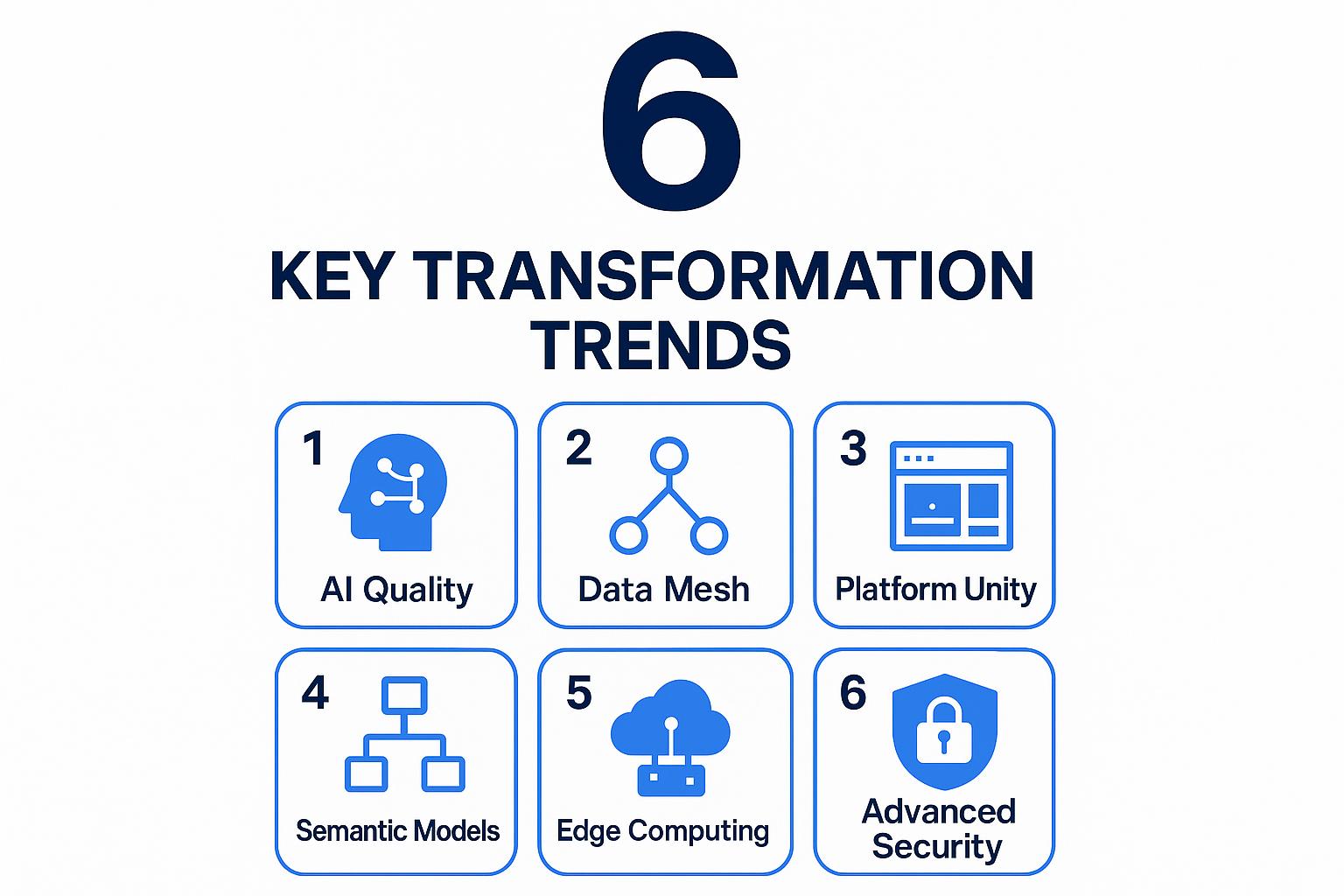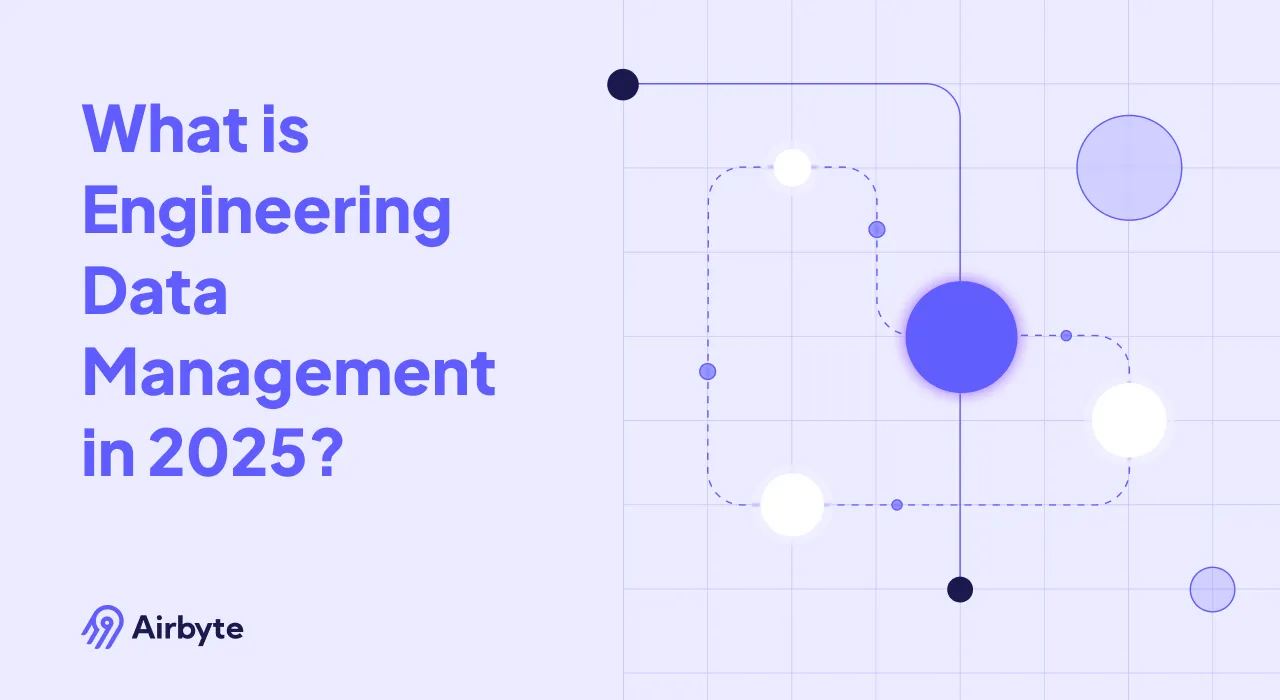What is Engineering Data Management in 2025?
Summarize this article with:
✨ AI Generated Summary
The article highlights the critical importance of modern engineering data management in ensuring seamless integration, accuracy, and security across complex, distributed data environments. Key points include:
- Engineering data management integrates diverse data types (sensor data, CAD files, simulations) with AI-driven validation, governance, and metadata management to improve decision-making and operational efficiency.
- Causal AI advances enable understanding of cause-effect relationships, enhancing prescriptive analytics and targeted interventions in engineering processes.
- Privacy-preserving technologies like homomorphic encryption facilitate secure collaboration on sensitive data without compromising intellectual property.
- Six major trends reshaping the field include AI-driven governance, data mesh models, semantic unification, platform consolidation, edge computing, and advanced security measures.
- Successful modernization requires assessing current maturity, upgrading integration and governance frameworks, adopting AI for data quality, and fostering organizational change.
A manufacturing company's production line stopped for three days because sensor data from different systems couldn't communicate. The CAD files showed one specification, machine outputs displayed another, and quality-control systems had a third version. By the time engineers determined which data to trust, they'd lost millions in downtime.
This scenario illustrates why engineering [data management](https://airbyte.com/data-engineering-resources/data-management) has evolved from simple file storage into a discipline that determines project success or failure.
Modern organizations require systems that handle sensor streams, simulation outputs, IoT data, and analytics pipelines working together seamlessly while maintaining security, compliance, and performance across distributed environments.
The convergence of artificial intelligence, edge computing, and advanced privacy technologies is creating unprecedented opportunities for engineering teams to extract value from their data assets while maintaining strict governance and operational reliability.
What Is Engineering Data Management and Why Does It Matter Today?
Engineering data management combines processes and systems that let you acquire, organize, analyze, and protect complex engineering data across distributed environments. You manage everything from design files and simulations to sensor outputs and operational logs throughout the product lifecycle, creating a unified foundation for data-driven engineering decisions and operational excellence.
Modern engineering data management leverages real-time integration with automated governance and intelligent metadata management. The discipline extends beyond storage to extracting actionable insights while maintaining quality, version control, and regulatory compliance across increasingly complex data ecosystems.
Advanced systems now incorporate artificial intelligence for automated data discovery, classification, and quality management, fundamentally changing how engineering teams interact with their information assets.
Core Components of Modern Engineering Data Management
Key components include data acquisition and processing across cloud and edge systems, comprehensive data governance frameworks that support access control and auditability, automated data validation to ensure accuracy and consistency at scale, seamless integration with analytics tools for downstream reporting and forecasting, and robust protection of sensitive data using advanced security measures.
Modern systems unify data from disparate sources into centralized databases or cloud storage solutions through intelligent integration platforms. Sensor data from machines, technical documentation, and analytics tools feed into unified platforms that leverage AI-powered data discovery and classification to improve efficiency and enable sophisticated data-driven decision-making.
This integration enables engineering teams to respond more quickly to operational changes while maintaining comprehensive oversight of their data assets.
Business Value for Your Team
Engineering data management directly impacts speed, accuracy, and competitive positioning in today's data-driven engineering landscape. As data volume grows exponentially and complexity increases, you need systems that manage information efficiently, protect sensitive assets, and provide robust foundations for advanced analytics and AI-powered insights.
Enterprise IT managers achieve lower total cost of ownership and stronger security postures through modern engineering data management approaches. Data engineers benefit from fewer broken pipelines and more consistent data flows through automated validation and quality management. Business-intelligence leaders gain faster access to trustworthy, analysis-ready data through modern engineering data management platforms.
How Do Causal AI and Advanced Analytics Transform Engineering Decision-Making?
The integration of causal artificial intelligence and advanced inference methodologies represents a fundamental shift in how engineering teams extract actionable insights from complex data ecosystems. Unlike traditional machine-learning approaches that rely heavily on correlation-based pattern recognition, causal AI enables organizations to understand true cause-and-effect relationships within their operational data.
This advancement moves teams beyond prediction to prescriptive analytics that can directly influence engineering outcomes and operational efficiency.
Understanding Causation vs Correlation in Complex Systems
Causal AI addresses one of the most persistent limitations in engineering analytics by distinguishing between correlation and causation in complex systems where multiple variables interact simultaneously. In manufacturing environments, traditional analytics might identify correlations between sensor readings and quality outcomes, but causal AI can determine which specific process parameters actually drive quality improvements.
This capability enables targeted interventions that deliver measurable results rather than broad changes that may or may not impact outcomes.
Real-World Impact on Engineering Teams
Engineering teams implementing causal AI approaches report significant improvements in decision-making accuracy and resource allocation efficiency. By understanding the causal mechanisms underlying system behavior, engineers can design more effective interventions, reduce waste from ineffective process changes, and build more reliable predictive models.
These models maintain accuracy even when operating conditions change, providing consistent value across different operational scenarios.
What Privacy-Preserving Technologies Enable Secure Engineering Data Collaboration?
The emergence of privacy-preserving computation technologies, particularly homomorphic encryption, is revolutionizing how engineering organizations collaborate on sensitive data while greatly enhancing security and intellectual-property protection. These advanced cryptographic techniques enable mathematical operations to be performed directly on encrypted data, producing encrypted results that match what would have been obtained from computations on the original plaintext.
Practical Applications in Engineering Environments
Practical applications include secure multi-party analysis of supply-chain data, collaborative R&D where competing organizations share insights without exposing underlying data, and cloud-based AI services that process sensitive engineering data without requiring decryption. These capabilities enable new forms of collaboration previously impossible due to security concerns.
Recent advances in hardware acceleration and algorithmic optimization have reduced the performance penalties traditionally associated with homomorphic encryption, making privacy-preserving computation viable for production environments.
What Are the Six Key Trends Reshaping Engineering Data Management?

1. AI-Driven Data Quality and Governance Revolution
Intelligent systems automatically validate incoming data streams, detect anomalies in real time, and implement dynamic access controls. These systems learn from patterns in your data to predict and prevent quality issues before they impact downstream processes.
2. Data Mesh and Domain-Driven Ownership Models
Distributed ownership empowers domain experts while centralized governance maintains consistency and compliance. This approach reduces bottlenecks by allowing teams to manage their own data while ensuring organization-wide standards.
3. Semantic Layer Unification and Knowledge Graphs
Semantic models connect CAD files, sensor logs, simulation outputs, and analytics reports into unified, queryable knowledge graphs. This creates a single source of truth that maintains relationships between different data types and sources.
4. Platform Consolidation and Open Standards Adoption
Teams standardize on open formats like Apache Iceberg, Delta Lake, and Parquet to eliminate vendor lock-in and improve interoperability. This approach ensures long-term flexibility while reducing integration complexity.
5. Edge Computing and Real-Time Streaming Architectures
Critical operational data is processed at the edge for faster response times and reduced latency. This enables real-time decision-making in manufacturing and operational environments where delays can be costly.
6. Advanced Security and Post-Quantum Preparedness
Organizations implement sophisticated access controls, encryption, and prepare for post-quantum encryption standards. This forward-thinking approach protects sensitive engineering data against both current and future security threats.
How Do You Build a Future-Ready Engineering Data Stack?
1. Assess Your Current Data-Management Maturity
Inventory capabilities and identify gaps in validation, version control, and governance. Understanding your current state provides the foundation for making informed decisions about modernization priorities and resource allocation.
2. Modernize Your Integration Architecture
Implement reliable mechanisms to ingest and organize data from cloud, on-premises, analytics tools, and IoT sources. Modern integration platforms provide the flexibility and reliability needed for complex engineering environments.
3. Implement Intelligent Data Quality and Monitoring
Leverage AI and machine learning to flag anomalies, enforce standards, and predict quality issues. Automated monitoring reduces manual overhead while improving data reliability across your entire ecosystem.
4. Strengthen Governance and Compliance Frameworks
Deploy sophisticated access-control policies and automated compliance monitoring. These frameworks ensure that data usage aligns with both internal policies and external regulatory requirements.
5. Develop Organizational Capabilities and Change Management
Invest in training and cultural alignment around data best practices. Technical solutions require organizational support to deliver maximum value and ensure sustainable adoption.
6. Build Strategic Vendor Partnerships
Choose solutions that support open standards and modular architectures. This approach provides flexibility while avoiding vendor lock-in situations that can constrain future technology choices.
What Are the Most Common Engineering Data Management Misconceptions?
Data Mesh Eliminates the Need for Centralized Governance
Decentralizing data ownership does not remove the requirement for robust governance; it heightens it. AI-assisted monitoring and intelligent metadata management are essential to balance autonomy with compliance.
The key is finding the right balance between distributed ownership and centralized oversight to maintain both agility and control.
AI Can Automatically Fix Poor-Quality Data
AI enhances validation but cannot compensate for inadequate source data. Robust data-quality practices at the point of collection remain fundamental to any successful engineering data management strategy.
Garbage in, garbage out remains true regardless of how sophisticated your AI systems become.
Cloud Storage Provides Automatic Security for Engineering Data
Security is a shared responsibility between cloud providers and organizations. You must implement access controls, encryption, and continuous monitoring to protect sensitive engineering data.
Cloud platforms provide tools and infrastructure, but security implementation and management remain your responsibility.
Where Is Engineering Data Management Evolving in the Future?
The future points to autonomous systems that self-organize data, predict quality issues, and optimize performance with minimal human intervention. Causal AI and privacy-preserving computation will unlock new collaboration models while protecting intellectual property. These advances will enable engineering teams to focus on innovation rather than data management overhead.
Start your modernization journey by assessing current processes, eliminating brittle integrations, and investing in scalable systems that support intelligent metadata management, automated validation, and domain-level ownership. The organizations that act now will have significant competitive advantages as these technologies mature.
Airbyte provides the foundation for modern engineering data management. With over 600 connectors and support for both open-source and cloud deployments, Airbyte delivers the flexibility and control needed to implement robust engineering data solutions that scale with your organization's needs.
Frequently Asked Questions
What is the difference between traditional data management and engineering data management?
Engineering data management specifically addresses the unique challenges of technical data including complex file formats, version control requirements, simulation data, and IoT sensor streams. It requires specialized tools and processes that understand engineering workflows and maintain data relationships across the product lifecycle.
How does engineering data management support compliance requirements?
Modern engineering data management platforms provide automated audit trails, access controls, and data lineage tracking that support regulatory compliance. These systems maintain detailed records of data usage, modifications, and access patterns required for industries like aerospace, automotive, and pharmaceuticals.
What are the key security considerations for engineering data management?
Security considerations include protecting intellectual property, controlling access to sensitive design data, encrypting data in transit and at rest, and maintaining data sovereignty requirements. Organizations must also consider supply chain security and collaboration requirements when designing their security frameworks.
How can small engineering teams implement effective data management without large IT resources?
Small teams can start with cloud-based platforms that provide enterprise-grade capabilities without requiring extensive infrastructure management. Focus on solutions that offer automated data quality, simple integration capabilities, and built-in governance features that scale with team growth.
What is the typical timeline for implementing a modern engineering data management solution?
Implementation timelines vary based on complexity and scope, but most organizations see initial benefits within weeks of deployment. Full implementation including data migration, process alignment, and team training typically takes several months depending on the size of existing data assets and number of integration points.
Suggested Read

.webp)
